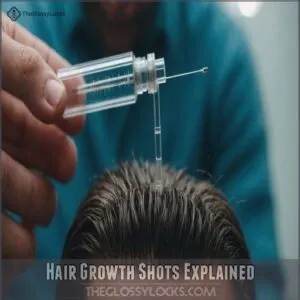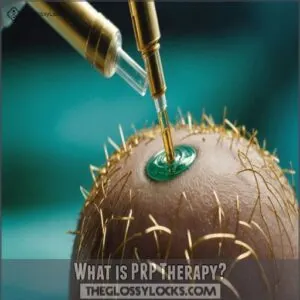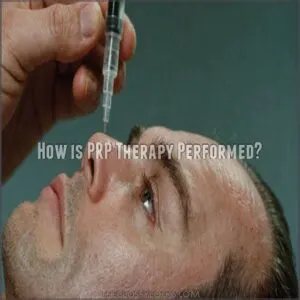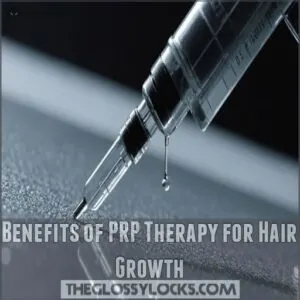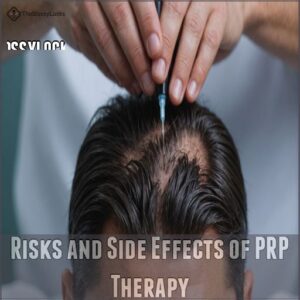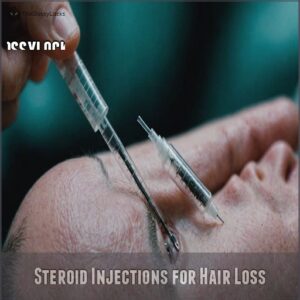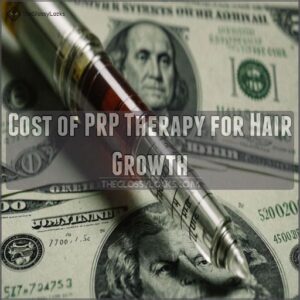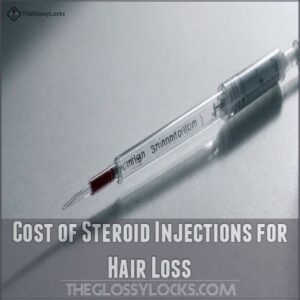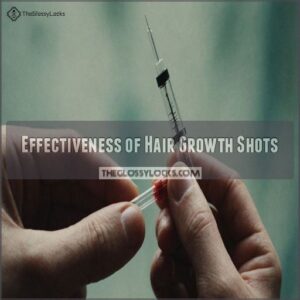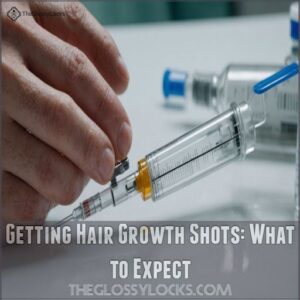This site is supported by our readers. We may earn a commission, at no cost to you, if you purchase through links.
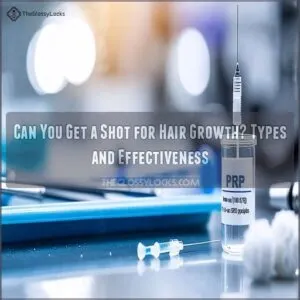 Yes, you can get shots for hair growth, and they’re more than just a fancy way to give your scalp a wake-up call.
Yes, you can get shots for hair growth, and they’re more than just a fancy way to give your scalp a wake-up call.
The most common option is PRP (Platelet-Rich Plasma) therapy, where doctors inject your own blood plasma, rich in growth factors, directly into your scalp.
Another option is steroid injections, particularly effective for specific types of hair loss.
These treatments work like a fertilizer for your follicles, stimulating dormant hair roots back into action.
While results vary, studies show promising success rates, especially when combined with other treatments.
Understanding your specific hair loss pattern, which may be influenced by factors such as temporary shedding after surgery, helps determine which injection type might work best.
Table Of Contents
- Key Takeaways
- Hair Growth Shots Explained
- PRP Therapy for Hair Growth
- Steroid Injections for Hair Loss
- Cost and Effectiveness of Hair Growth Shots
- Getting Hair Growth Shots: What to Expect
- Frequently Asked Questions (FAQs)
- Do PRP injections increase hair growth?
- What works best for hair growth quickly?
- Are steroid injections good for hair loss?
- Do Corticosteroids promote hair growth?
- Do hair growth supplements really work?
- Are steroid injections bad for your hair?
- Is there an injection for hair growth?
- Can I get shots in my head for hair growth?
- How much does the hair growth injection cost?
- How much do hair injections cost?
- How long do results from hair growth shots last?
- Can hair growth injections be combined with other treatments?
- Are there age restrictions for getting hair shots?
- How many sessions are typically needed for optimal results?
- Do hair growth shots work for all hair types?
- Conclusion
Key Takeaways
- You can get two main types of hair growth shots: PRP therapy (using your own blood plasma) and steroid injections, with PRP showing more promising results for most people.
- You’ll need to invest $500-2,500 per PRP session or $50-300 for steroid injections, typically requiring multiple treatments spaced 4-6 weeks apart for optimal results.
- You’ll see varied results based on your specific hair loss pattern, and you’ll need maintenance treatments every 4-6 months to sustain the improvements.
- You should expect minimal downtime after the procedure, but you’ll need to follow specific aftercare instructions like avoiding hair washing for 24 hours and strenuous exercise for 48 hours.
Hair Growth Shots Explained
If you’re wondering about hair growth shots, you’re not alone in seeking solutions for thinning hair.
These shots, like PRP therapy, involve injecting substances into the scalp to boost hair density and thickness effectively.
What Are Hair Growth Shots?
Hair growth shots, like PRP therapy, are injections aimed at reviving your hair hustle.
These scalp injections use things like platelet-rich plasma to kickstart hair growth.
Imagine giving your hair roots a pep talk!
While promising, they’re not magic potions.
Costs and risks of hair growth shots vary, so consider alternatives and chat with a pro first.
How Do Hair Growth Shots Work?
Once you’ve got a grasp on hair growth shots, it’s fascinating to see how they work.
Imagine this: growth factors, like tiny gardeners, are injected through methods like platelet-rich plasma therapy, a technique that can be as subtly persuasive as using "encrypted language" in the Obsession Method.
They stimulate those lazy hair follicles and boost blood flow, nudging them to wake up and grow.
It’s a straightforward yet intriguing process, making scalp injections a key player.
Types of Hair Growth Shots
Ever wondered which hair growth shots are best?
You’ve also got options like dermarolling, which involves using a derma roller with tiny needles to create micro-injuries on the scalp’s surface, stimulating collagen and elastin production through microneedling for hair growth. You’ve got options: PRP therapy, or platelet-rich plasma, taps into your blood’s growth factors to boost hair regrowth.
Steroid injections can tackle inflammation-related hair loss.
Alternative treatments might include vitamin boosters.
Consider cost comparisons, weigh side effects, and think about long-term effects for a success rate that suits you.
PRP Therapy for Hair Growth
When you’re looking to boost hair growth, understanding that genetics and hormones influence hair growth rate. PRP therapy might catch your interest.
This treatment uses your own blood to naturally stimulate hair follicles and promote thicker hair, making it a cutting-edge option worth considering.
What is PRP Therapy?
Thinking about PRP for hair loss?
It’s a treatment using your own blood.
Specifically, we extract platelet-rich plasma (PRP), which is packed with growth factors.
These factors stimulate your hair follicles, potentially boosting growth and thickness.
It’s a relatively new approach, but early research shows promise.
Want to know more about its safety and cost?
Let’s explore!
How is PRP Therapy Performed?
PRP therapy for hair growth starts with a simple blood draw.
Here’s the drill: after drawing the blood, it’s all about spinning magic in the centrifugation step to get that PRP concentration.
Next, comes the scalp injection with precision.
- Gentle blood draw
- Centrifugation to concentrate PRP
- Expert injection technique
- Follow post-treatment care
Who knew science could be this down-to-earth?
Benefits of PRP Therapy for Hair Growth
Hair growth treatment for alopecia can include various options like topical corticosteroids and minoxidil, which stimulate hair regrowth. Jump into hair growth with PRP therapy‘s benefits.
This treatment uses your own blood to boost hair regrowth and density.
You can also explore products related to hair growth injections online, such as those found at hair growth injection solutions.
The magic happens as platelet-rich plasma increases blood supply to follicles, sparking hair growth stimulation and making strands thicker.
With PRP results showing promise, it stands out as a viable option for hair growth injections.
Risks and Side Effects of PRP Therapy
While PRP therapy offers potential benefits for hair growth, it’s important to acknowledge the risks.
Here’s the scoop on PRP side effects: Pain or discomfort during hair growth injections can occur.
Swelling or temporary discoloration might follow, but they usually fade quickly.
Allergic reactions are unlikely as PRP uses your own blood), but always consult your doctor about PRP risks for hair loss.
Steroid Injections for Hair Loss
You’ve likely heard of steroid injections for various medical conditions, but did you know they can also be used to combat hair loss?
These shots work by reducing inflammation around hair follicles, potentially stimulating growth and slowing down hair thinning in certain types of alopecia.
What Are Steroid Injections?
Moving from PRP therapy, let’s talk about steroid injections for hair loss.
These shots contain synthetic versions of hormones your body naturally produces.
They’re designed to reduce inflammation and suppress the immune system, which is particularly beneficial for conditions like alopecia areata treatment options.
Here’s a quick breakdown of steroid injections:
| Type | Common Use | Duration |
|---|---|---|
| Cortisone | Alopecia areata | Short-term |
| Triamcinolone | Pattern baldness | Medium-term |
| Dexamethasone | Severe hair loss | Long-term |
| Prednisolone | Scalp inflammation | Variable |
| Betamethasone | Autoimmune hair loss | Short to medium |
How Do Steroid Injections Help With Hair Loss?
Steroid injections can be a game-changer for hair loss sufferers.
They work by reducing inflammation around hair follicles, which can interrupt the normal growth cycle.
These shots also boost blood flow to the scalp, nourishing follicles and promoting growth.
By suppressing your immune system’s attack on hair follicles, steroids can help halt hair loss and encourage regrowth.
However, results vary, and it’s important to consult a dermatologist before starting treatment.
Types of Steroid Injections for Hair Loss
There are several types of steroid injections used for hair loss.
The most common is triamcinolone acetonide, often used for alopecia areata.
Corticosteroids like dexamethasone and betamethasone are also options.
These injections work by reducing inflammation and suppressing the immune response that attacks hair follicles.
For those looking to try hair loss steroid shots, numerous products and treatments can be found through online platforms like steroid shot products.
Your dermatologist will choose the best type based on your specific condition, hair loss pattern, and medical history.
Remember, results can vary, it’s not a one-size-fits-all solution.
Risks and Side Effects of Steroid Injections
Considering the risks of steroid injections for hair growth?
While they can be effective, it’s important to understand potential side effects.
You might experience allergic reactions, skin thinning, or muscle weakness.
Long-term use can even lead to bone loss.
It’s a balancing act between potential benefits and risks.
Always consult with a healthcare professional to weigh your options and determine if steroid injections are right for you.
Cost and Effectiveness of Hair Growth Shots
You’re probably wondering if hair growth shots are worth your hard-earned cash.
While PRP therapy can set you back $500 to $2,500 per session, its effectiveness in promoting hair growth and thickness is supported by several studies, though results may vary from person to person.
Cost of PRP Therapy for Hair Growth
PRP therapy for hair growth isn’t cheap.
You’re looking at $500 to $2,500 per session, depending on factors like your location and the clinic’s reputation.
Most folks need multiple treatments, typically spaced 4-6 weeks apart.
Insurance usually won’t cover it, as it’s considered cosmetic.
But don’t lose hope!
Some clinics offer payment plans to make it more manageable.
Always check a clinic’s track record before committing.
Cost of Steroid Injections for Hair Loss
Steroid injections for hair loss typically cost less than PRP therapy.
You’re looking at $50 to $300 per session, depending on your location and the specific treatment.
Insurance might cover it if it’s deemed medically necessary, but often it’s considered cosmetic.
Keep in mind, you’ll likely need multiple treatments over time to maintain results, so factor that into your budget planning.
Effectiveness of Hair Growth Shots
Hair growth shots have shown promising results, but effectiveness varies.
PRP therapy often yields better outcomes than steroid injections, with studies indicating improved hair density and thickness.
However, individual results can differ greatly.
While some patients experience noticeable regrowth, others may see minimal changes.
It’s important to manage expectations and understand that these treatments aren’t miracle cures.
Consult a specialist to determine if hair growth shots are right for you.
Factors Affecting The Cost of Hair Growth Shots
Several factors influence the cost of hair growth shots.
Where you get them matters – big city clinics often charge more.
How often you need treatments and the amount injected play a role too.
Your doctor’s experience can bump up the price, but it might be worth it for better results.
Some places offer package deals or bundle PRP therapy with other hair restoration services, potentially saving you money in the long run.
Getting Hair Growth Shots: What to Expect
You’re about to start a hair-raising adventure with hair growth shots. From prep to post-care, we’ll guide you through what to expect when getting these follicle-stimulating injections.
Pre-Procedure Preparations
Before diving into hair growth shots, you’ll need to prep properly.
Your doctor will walk you through the process, but here’s a quick rundown of what to expect:
- Schedule a consultation
- Review your medical history
- Discuss current medications
- Complete necessary bloodwork
- Adjust your diet if needed
These steps help make sure you’re ready for PRP therapy or other hair growth treatments.
Remember, setting realistic expectations is key. Don’t be shy about asking questions – it’s your scalp, after all!
The Procedure: What to Expect
During your hair growth treatment session, you may consider combining this with an Ayurvedic hair growth approach that treats the underlying imbalances that cause hair loss. You’ll sit comfortably while a medical professional draws blood for PRP therapy.
The drawn blood goes through centrifugation to separate platelet-rich plasma.
You’ll receive local anesthesia to minimize discomfort before the doctor injects the PRP into specific areas of your scalp.
The entire procedure typically takes 30-60 minutes, and most people report minimal pain, describing it as mild pressure sensations.
Post-Procedure Care and Recovery
After your hair growth injection, recovery is straightforward. You’ll need to follow specific care instructions to maximize results. Here’s what you can expect in the days following treatment:
- Mild soreness at injection sites for 24-48 hours
- Slight scalp redness that fades within 2-3 days
- Return to normal activities immediately, but avoid strenuous exercise for 48 hours
- Wait 24 hours before washing your hair to prevent irritation
Keep the area clean and avoid scratching to promote proper healing.
Maintenance Treatments for Hair Growth Shots
Hair growth treatments like Rogaine Minoxidil Treatment have been clinically proven to boost hair thickness by up to 48%. Regular maintenance treatments keep your hair growth results going strong.
You’ll typically need follow-up shots every 4-6 months, depending on your treatment plan and progress.
Here’s what to expect for different hair growth shots:
| Treatment Type | Follow-up Schedule | Average Cost Per Year |
|---|---|---|
| PRP Therapy | Every 4-6 months | $2,000-4,000 |
| Steroid Injections | Every 3-4 months | $1,200-2,400 |
| Growth Factor Shots | Every 6-8 months | $1,800-3,600 |
| Vitamin Cocktails | Every 2-3 months | $800-1,600 |
Frequently Asked Questions (FAQs)
Do PRP injections increase hair growth?
PRP injections can stimulate hair growth by using your own blood’s platelets to activate dormant follicles.
PRP injections are effective at increasing hair density and thickness.
You’ll need multiple treatments for best results.
What works best for hair growth quickly?
Like a seed needing fertile soil, your hair needs proper nourishment to flourish.
Minoxidil, biotin supplements, and PRP therapy can boost growth, while maintaining a healthy diet rich in proteins and vitamins supports rapid results.
Are steroid injections good for hair loss?
While steroid injections can help with certain types of hair loss, they’re not recommended as a first-line treatment.
They come with potential side effects and aren’t as effective as other options like PRP therapy.
Do Corticosteroids promote hair growth?
As sure as spring brings new growth, corticosteroid injections can stimulate hair regrowth in some cases of alopecia.
They work by reducing inflammation in your scalp, but they’re not a guaranteed solution for everyone.
Do hair growth supplements really work?
Hair growth supplements show mixed results.
Some ingredients like biotin and iron might help if you’re deficient, but there’s limited scientific evidence supporting their effectiveness.
It’s best to consult your doctor first.
Are steroid injections bad for your hair?
Despite popular myths, steroid injections can harm your hair follicles over time.
They’re linked to thinning, scalp atrophy, and potential hair loss.
You’ll want to explore safer options like PRP therapy instead.
Is there an injection for hair growth?
Yes, PRP therapy offers injections using your own blood’s platelets to stimulate hair growth.
You’ll need multiple sessions, and while it’s not cheap, research shows promising results for improving hair thickness and density.
Can I get shots in my head for hair growth?
Promising PRP therapy offers scalp injections that stimulate hair growth using your own blood’s platelets.
You’ll get these shots directly in your head through sessions that typically cost between $500-$2,500 per treatment.
How much does the hair growth injection cost?
PRP hair growth injections typically cost between $500-2,500 per session, with most people needing three sessions. Insurance rarely covers it since it’s considered cosmetic. You’ll likely need to pay out-of-pocket.
How much do hair injections cost?
Hair growth injections typically cost between $500-$2,500 per session. You’ll likely need multiple treatments, and since it’s considered cosmetic, insurance won’t usually cover it. Some clinics offer payment plans.
How long do results from hair growth shots last?
Time flies when you’re seeing results! Your growth shots typically last 4-6 months per treatment, but you’ll need maintenance sessions every few months to keep your hair gains going strong.
Can hair growth injections be combined with other treatments?
You can combine PRP injections with other treatments like minoxidil, finasteride, or laser therapy for enhanced results.
Talk with your doctor to create a personalized plan that’ll work best for your specific needs.
Are there age restrictions for getting hair shots?
Like a ripe fruit ready for picking, PRP hair therapy is typically safe for adults 18 and older.
While there’s no strict upper age limit, you’ll want a doctor’s evaluation to confirm you’re a good candidate.
How many sessions are typically needed for optimal results?
Most patients need 3-4 initial PRP sessions spaced 4-6 weeks apart for the best hair growth results. You’ll likely need maintenance treatments every 4-6 months to sustain the improvements long-term.
Do hair growth shots work for all hair types?
While PRP shots work effectively for many hair types, they’re not a one-size-fits-all solution.
These treatments typically show better results for androgenetic alopecia and thinning hair, regardless of texture or ethnicity.
Conclusion
Like the legendary phoenix rising from the ashes, your hair growth journey can take flight with the right treatment approach.
Whether you decide to get a shot for hair growth through PRP therapy or steroid injections, success depends on choosing the right treatment for your specific condition.
While these shots aren’t magic bullets, they offer scientifically-backed solutions for many people struggling with hair loss.
Consult with a qualified dermatologist to determine if hair growth shots could work for you.

